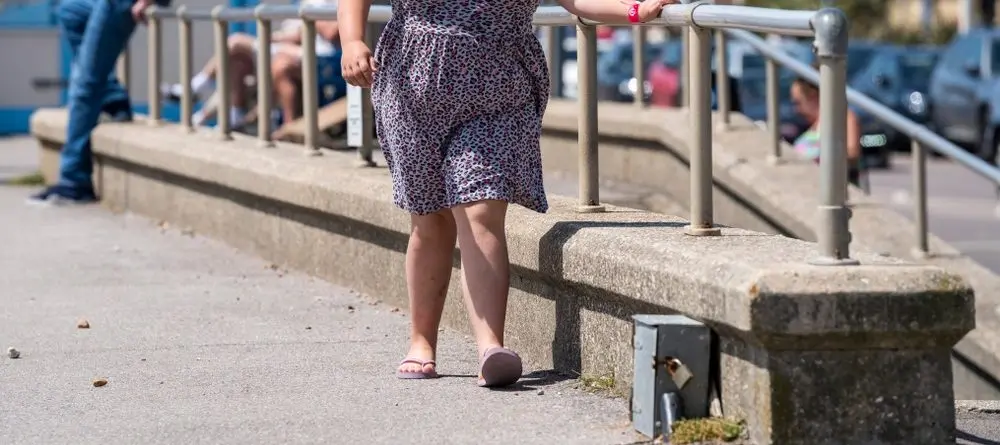
Genu valgum, commonly known as knock-knees, are generally present from childhood.
The varum knee, unlike the valgus knee, shows in youngsters as a cowboy-like outward deviation of the joint.
The valgus knee, on the other hand, produces inward movement of the knees.
If left untreated, this condition makes it difficult to move the legs and feet. It can eventually damage the joint cartilage, resulting in knee osteoarthritis.
This is why detecting symptoms and implementing a customized treatment plan are critical for this condition.
Symptoms and complications
Valgus knee is seen as a juvenile physiological abnormality.
At birth, most infants will have some outward deviation of the lower limbs.
Later on, this deviation will tend to be reversed in the first years of life. Genu valgum is the medical term for this condition.
However, if the axial deformity of the lower limbs continues throughout maturity, it becomes more troublesome.
It generally leads to:
- A pronounced inward deviation of the knees
- A protrusion on the affected knee
- Difficulty in moving around properly
- Pain in the lower limbs
- A noticeable stiffness in the knees
- Pain in the feet, ankles or hips
- Lack of balance in an upright position
- Stiffness in the joints adjacent to the knees
Untreated knock-knees can also lead to the development of osteoarthritis in more severe instances.
What causes knock-knees
Valgus knees are most commonly seen in children. This basic, natural alignment can sometimes grow more apparent, resulting in a deformity that might cause difficulties in the future.
Hyperlaxity of the ligaments causes excessive valgus knee in children, which generally disappears before adolescence. When the joint deformity lasts longer than 7 or 8 years, it becomes pathological.
When the deformity is significant from a young age, the valgus knee can also be deemed pathological.
Several factors, in addition to the genetic component, can contribute to the development of valgus knee.
We can consider, for example:
- A fracture that hasn’t fully healed
- Obesity
- An injury to the tibia
- A malformation of the bone tissue
Valgus knee prevention
Even if a child’s valgus knee usually resolves, this is not always the case. It is therefore critical to treat it before it has a negative influence on the affected person’s quality of life.
To this end, there are a number of preventative measures that may be taken:
- Maintaining a healthy weight
- Introducing a regular physical activity routine
- Wearing stabilizing heels in shoes (for asymmetrical valgus knees)
Treatments for children and adults
When a child develops valgus knee, it’s critical to assess the situation.
Although it will usually cure on its own, it is better to avoid the danger of developing a severe valgus knee.
Both adults and children can have valgus knee, which can be diagnosed by a podiatrist. This foot expert also offers adapted and, if the case allows, minimally invasive treatments.
To treat a valgus knee, the podiatrist may turn to:
- Foot orthotics to restore or reposition the knee in a more regular axis
- Knee strengthening exercises
Naturally, the podiatrist will do everything possible to refer the patient to conservative treatment options. However, if traditional physical therapy fails, a pediatric orthopedist’s surgery may be the last resort.
For elderly people with a valgus knee that has too much deviation or creates issues with locomotion, the following procedures may be considered:
- The installation of unicompartimental prostheses, which partially replace the affected joints
- Total prosthesis, which fully replaces the damaged joints. This procedure, however, is only done when the cartilage has been damaged by osteoarthritis.
- An osteotomy, which consists of cutting the affected bones in order to modify the incorrect axis of the lower limbs. Metal components like nails, plates, or rods are used to hold the bones in place once they have been shaped.
Epiphysiodesis is one of the most prevalent surgical treatments in younger individuals with significant injury.
By intervening directly on the bones, this operation slows down the development of the growth plate. It cannot, however, be done on children under the age of 11.
Early treatment of the valgus knee lowers the likelihood of problems like osteoarthritis and enhances the quality of life of the adult who suffers from it.
PiedReseau – Learn more
Are you interested in learning more about valgus knee? PiedReseau often publishes informative articles!
Despite the fact that the PiedReseau website is a wealth of information, nothing matches a face-to-face consultation with a podiatrist.
Take care of your feet, they’re precious!